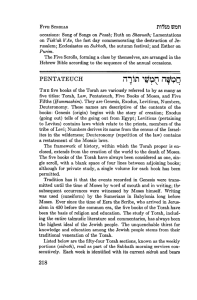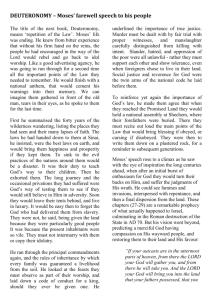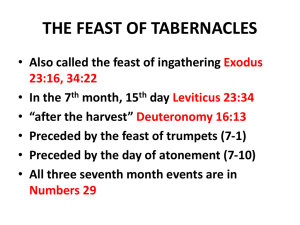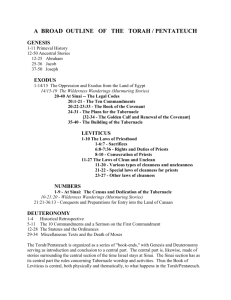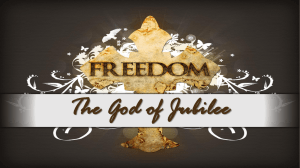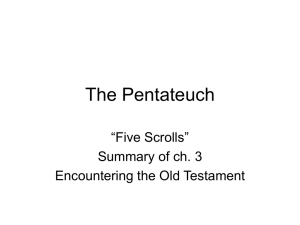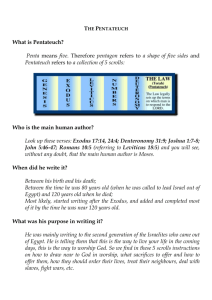OTS501_III_Torah II_Lev to Deut_2015
advertisement
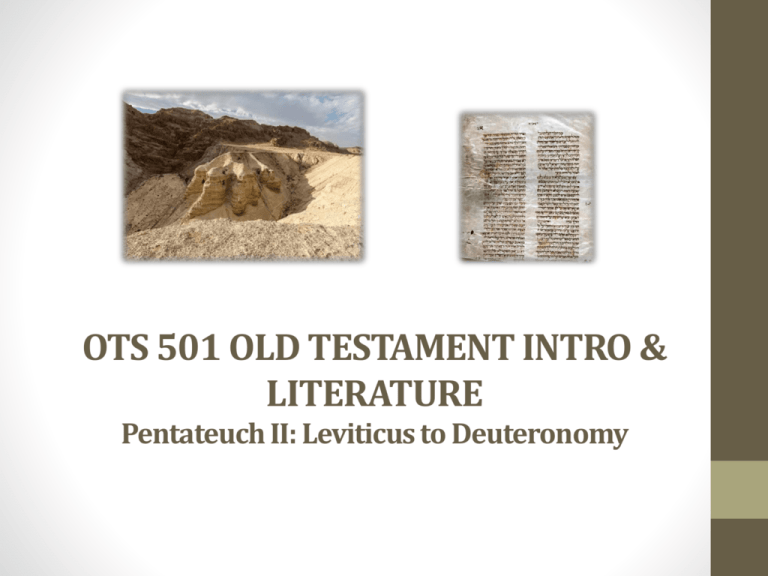
OTS 501 OLD TESTAMENT INTRO & LITERATURE Pentateuch II: Leviticus to Deuteronomy Torah II – Leviticus to Deuteronomy 1.1 Introduction - Leviticus • Why is Leviticus in the Bible? • What is the relevance of Leviticus for Christians • Sacrificial system • Purity rules • Feasts and festivals • How many sermons have you heard on Leviticus? Torah II – Leviticus to Deuteronomy • Narrative connection w/ Exodus (Ex 40:33-38) • Scene at the Tent of Meeting (Lev 1:1) • Natural extension of Ex 25-40 • Name “Leviticus” • Hb. “and he called” [Hb. wayyiqra] • Gr. ‘pertaining to the Levites’ [Gr. leuouitikos] Torah II – Leviticus to Deuteronomy 1.2 Historical and Critical Issues • Authorship and Composition • No human authors mentioned • “LORD said to Moses” over x25 • Traditional view – Moses wrote • Jewish and Christian tradition • By analogy from Exodus • Early (c. 1400 BC) or late date (c. 1200 BC) Torah II – Leviticus to Deuteronomy • Documentary hypothesis • Nearly all of Lev attributed to P-source • Contains priestly, legal, cultic materials • Composed by priest(s) b/w 550-450 BC • Author (Moses) + editor • Pre-exilic P source due to similarities b/w Lev, Judg, 1 Sam • holiness; war; sacrifices (e.g. Lev 17:10-16/1 Sam 14:33-34) • Lev & other pre-exilic sources (Deut 26:14; Ez 18:13; 20:9) • Open question • Did Moses write all or parts or dictate Levitical material to a scribe? • The extent of later editorial work Torah II – Leviticus to Deuteronomy 1.3 Purpose and Structure • Purpose of Leviticus • Give instructions in holiness (11:44-45) • God’s character and how to approach Him • Worship: priestly procedures • Daily living: conduct of lay people • Structure – various possibilities • Approaching a Holy God (1-10) • Living in the presence of the Holy God (11-25) • Covenant sanctions + appendix (26-27) Torah II – Leviticus to Deuteronomy • More detailed outline 1. Sacrificial laws (1:1-7:38) • Instructions to laity (1:1-6:7) 2. Priestly narrative (8:1-10:20) • Formal beginnings of the priesthood (8:1-9:24) • The limits of the priesthood – Nadab and Abihu (10) 3. Laws to protect ritual cleanness (11:1-16:34) • • • • • Dietary prescriptions (11) Birth laws (12) The discernment & cleansing of skin diseases (13-14) Laws about bodily discharges (15) Day of atonement (16) 4. Holiness code (17-27) • Various laws [purity, festivals, sacred times (17:1-25:55)] • Blessings and curses (26) • Gifts to the Lord (27) Torah II – Leviticus to Deuteronomy 1.4 Themes of Leviticus • Holiness and Purity • Holiness as separation from mundane sphere • Holy - conformity to God • Categories of purity and holiness HOLY & COMMON IN ANCIENT ISRAEL HOLY COMMON Clean --- Unclean Torah II – Leviticus to Deuteronomy • Holiness of YHWH & sanctification • Process of sanctification • Human activity • Divine sanctification (cf. Lev 21:8) • Process of profanation & pollution • Disease, sin, contamination etc. Sanctify HOLY Cleanse CLEAN Profane “SEPARATED” UNCLEAN Pollute “NORMAL” “ABNORMAL” Torah II – Leviticus to Deuteronomy • Holy – God as separate • Common/clean • ‘Normal’ state of human beings, living creatures & objects • Unclean • Caused by… • • • • Sin Foods (Lev 11) Child birth & other bodily states (Lev 13-15) Certain diseases & mildew (Lev 13-14) Torah II – Leviticus to Deuteronomy • Importance of holiness & purity • Purity & holiness – not identical w/ modern ‘moral conduct’ • Ascending degrees of holiness & purity • From Holy of holies to ‘outside the camp’ God’s very presence to gentile territory (cf. the Temple & Garden of Eden) • Practical ways of removing impurity • Ritual washing • Sacrifices Torah II – Leviticus to Deuteronomy • Theories of purity – why did God require purity • Health and hygiene (e.g. incest law & kosher Lev 18; 20; 11) • Fails short of holistic explanation • To separate Israel from idolatry • Accounts only for some laws • Holiness = wholeness – conformity to class • • • • E.g. unclean animals fish w/o fins and scales (Lev 11:10) Certain type of movement (‘swarming’) = unclean Skin disease = unclean BUT… being wholly covered w/ disease = clean (Lev 13:12-17) Torah II – Leviticus to Deuteronomy • Sacrificial system • Sacrifice and covenant connection • Gift from worshipper to the LORD • Fellowship w/ LORD • Healing a rift in covenant relationship - expiation • Provided access to the presence of the holy God • Making unholy pure and holy again – restored access to holy God • Principle of life & blood (17:11) – death makes sacrifice effective • Reconciliation & fellowship w/ YHWH • Not for the purpose of “getting to heaven” • Other elements: faith, prayer, and contrition (cf. Jer 29:12; Is 66:2) • Preserve YHWH in their midst & remind of God’s holiness • Two types of sacrifices • Spontaneous – thanksgiving for blessings (e.g. 2:1-16) • Those demanded by YHWH to atone for sin (1:3-17; 4-6:7) Torah II – Leviticus to Deuteronomy • Hebrew sacrificial system & ANE rituals • ANE had highly structured priestly classes • Elaborate ceremonies & sacrificial systems • ‘Burnt’ and ‘peace’ offerings akin to Leviticus • Ceremonial washings • Anointing & purification rituals • Some differences • • • • Prohibition of human sacrifices Holy and righteous character of YHWH (not unpredictable) Ethical and moral nature of Hebrew religion The origin and impact of human sin Name Portion burnt Other portions Animals or sacrifice Occasion or reason Ref. Torah II – Leviticus to Deuteronomy Burnt offering All None Male w/o blemish; acc. to wealth Grain offering Eaten by priests Grain or Thanks; firstfruits unleavened cakes • s Small part sacrific. Propit. for general Lev 1 sin; dedication Fellowship: a) unexpect. blessing b) deliverance & vow c) general thx. giving d) expiation Lev 2; 6:14-23 Peace/fellows Fat hip offering: portions a) Thx offering b) Vow offering c) Freewill offering Fellowship Male or female meal – w/o blemish; acc. Lord, to wealth priest & offerer Lev 3; 7:11-38; 22:18-30 Sin/purific. offering Fat portions Eaten by priest Bull (priest), male Purification and or female goat removal of sin (king, individual ) Lev 4 Guilt offering Fat Eaten by priest Ram w/o blemish Desecration of + 20% payment something holy Lev 5:1-67; 7:110 Torah II – Leviticus to Deuteronomy • Social justice and the covenant people (cf. also Ex 20-23) • Basis in Israelite experience – Exodus and liberation “do not oppress the alien…you were aliens in….Egypt” (19:33-4) • Neighbor responsibilities (19:1-18, 29-37) • • • • “reaping the edges” & the poor (19:9-10) Not taking advantage of the neighbor (19:11-18) Justice for the poor (19:15) Truth-telling & just business transactions (19:35-37) • Sacrificial system • According to wealth: sheep, goat, birds, grain (1:10-17; cf. 5:7-13) Torah II – Leviticus to Deuteronomy • Sabbath year & Jubilee year (25:1-55) • “holiness” of human time – Sabbath • Sabbath as a covenant sign, provision and creation • Rest for the land – Sabbath year (25:1-7, 20-23) • For the poor and disadvantaged • For the fields and animals • Test of faith - “what shall we eat then?” • The Jubilee year (25:8-55) • Return of property to original owners – “the land is mine” • Just selling & buying of property in light of Jubilee • Release of impoverished Hebrews w/ land (cf. landless in Ex 23:10-11) Social and economic equality & realism Prevented accumulation of property Thanks-giving for provision & dependence on YHWH Consequences for disobedience devastating (Jer 25:8-14; 2 Chr 36:17-21) Torah II – Leviticus to Deuteronomy 2.1 Introduction to Numbers • What are some of the familiar stories in Num? • How does Numbers fit into the Pentateuch as a whole? • How many sermons have you heard on Numbers? Torah II – Leviticus to Deuteronomy • The name “Numbers” • Gr. artithmoi (LXX) – numbers • Censuses (Num 1; 26) • Hb. bemidbar – in the wilderness • Wilderness wandering • Narrative connections • From Sinai (1:19) to wilderness (10:11-12) to plains of Moab (22:1) • From old generation to new generation • Toward the promised land and new hope Torah II – Leviticus to Deuteronomy 2.2 Historical and Critical Issues • Authorship and composition • One reference to Moses’ writing activity (33:1-2) • Priests’ writing activity (5:23) • Traditional authorship – Moses • By analogy from Exodus • early or late date (1400BC or 1200BC) • Documentary hypothesis • P source dominates (1-9; 15; 17-19; 26-31; 33-36) • JE source Final priestly editing in the 5th century BC Torah II – Leviticus to Deuteronomy • One author (Moses) + editing • Essential authorship/source is Moses • Possible sources and/or editing • • • • • • • Moses’ travel log (Num 33) Census accounts (Num 1; 26) “Book of the Wars of the LORD” (Num 21:14-15) Building activity of settled tribes (32:34-42) Balaam stories (22-24) Ballad about Heshbon (21:27-30) Moses as the “most humble” man (12:3) • The extent of editing open Torah II – Leviticus to Deuteronomy 2.3 Purpose and Structure • Purpose of Numbers • • • • Cataloging the Hebrew’s experiences outside of Egypt To demonstrate God’s faithfulness and human sinfulness Consequences of rebellion – as a warning (cf. 1 Cor 10:11) Preparation for the new generation • Structure – roughly chronological sequence • Sinai (1-10:10)-Kadesh (10:11-20:13)-Moab (20:14-36:13) OR • The OLD generation (1-25) and the NEW generation (26-36) Torah II – Leviticus to Deuteronomy • Chronological stages in Numbers • 20 days in Mt. Sinai from completion of tabernacle to follow the cloud of glory (1:1-10:11) • 38 yrs. in wilderness (unbelief) – Sinai to Kadesh (10:11-20:13) • 6 months from Kadesh to plains of Moab – 2nd gen. (20:14-36:13) In Num 1:1 (cf. Ex 40:17),the Tabernacle has been standing for app. 1 month and the Hebrews have been at Sinai for app. 1 yr. Torah II – Leviticus to Deuteronomy 2.4 Themes in Numbers • Census and numbers • Why have the censuses? (cf. 2 Sam 24 & Ex 30:11-16) • ANE background & censuses • Recruiting men for war (cf. Num 1:3) • Forced labor for the rulers • Taxation Feared practices associated w/ bad luck • In Numbers 1; 26 – censuses of old & new generation • Organization of the newly formed people • Military count for the conquest Torah II – Leviticus to Deuteronomy • What about the actual figures? (2:32 = 603,550; 26:51 = 601,730) • Taken literally – total population 2-3 million • Fits well Pharaoh’s fear (cf. Ex 1:7-12) • How did wilderness support such a number? • How did Hebrews fail to subdue Canaanites? (cf. Judg 1-3; 3:5) • Alternative explanations for the figures • Exaggerations • Literary fiction, misplaced numbers etc. • Hb. “thousand” (’lp) may mean “unit” [w/ different vowels] – thus thousand would mean ‘unit’, ‘clan’, ‘tribe’ or alike Total of 18,000-100,000 men (72,000-400,000 people in total) Torah II – Leviticus to Deuteronomy • Sin, judgment & hope • Rebellion of people – the old generation • Rebellion of priests & people (11-12; 14:1-12; 16-17; 20:1-13; 21:5) • Rebellion of Aaron, Miriam & Moses (12:1-16; 20:1-13) • Judgment (& mercy) of God • Destruction of the wilderness generation (13-14) • Unbelief & rebellion • God’s faithfulness • Joshua and Caleb as ‘remnant’ (26:26-35) • Judgment & mercy (21:1-3, 4-9, 21-35; 22-24; 24:11) • Balaam – curse and blessing (22-24; 25:1-3; 31:8-16; cf. Jude 11) Torah II – Leviticus to Deuteronomy • Hope – the emerging generation (26:65) • Military victories (31:1-12) • Crises resolved b/w Rueben and Gad (32:1-42) • New laws w/ view to conquest (34-36) • Cities of refuge & blood vengeance (35:9-28) God’s faithfulness and hope for the new generation • Numbers & ANE cultures • • • • • Cities of refuge – not in ANE Inheritance to daughters (if no sons; Num 27:1-11; 36:1-13) – not in ANE Nazirite vows (Num 6:1-21) – reflects ANE practice “adultery test” (Num 5:11-31) & Mesopotamian law (river god id)* Balaam’s oracle & divine revelation (22-24; 24:2-4; 25:1-3; cf. 31:8-16) • Balaam text of Deir ‘Alla** – prophecy of Balaam & displeasure of the divine council (8th century BC) • Demonstrate YHWH’s sovereignty over the nations Torah II – Leviticus to Deuteronomy Inscription of Balaam son of Beor, the prophet, man of the gods. Behold, the gods came to him at night, and [spoke to] him according to these words, and they said to [Balaa]m son of Beor thus: "The [Light] has shone its last; the Fire for [judgment] has shone." And Balaam arose in the morning, [ ] days, [], and cou[ld not eat], and he wept bitter tears. And his people came up to him and they [said] to Balaam son of Beor: "Why are you fasting and why are you weeping?" And he said to them: "Return! I shall tell you what the gods (shaddayim) are [. . . . . . . . . . . . . . .] Go on, consider the doings of the gods.“* Torah II – Leviticus to Deuteronomy 3.1 Introduction to Deuteronomy • What is the purpose of Deuteronomy? • How is Deuteronomy connected to Numbers? • Some significant parts or stories in Deuteronomy? • Quotes of Deuteronomy in the NT? Torah II – Leviticus to Deuteronomy 3.2 Historical and Critical Issues • Authorship and composition • Parts attributed to Moses (31:24; cf. 27:3, 8; 29:21; 30:10) • Traditional authorship – Moses • Jews and Christians throughout the centuries • Inferred from 31:24 and by analogy • Documentary hypothesis & Deuteronomistic history • Largely D-source – late 7th century BC • Based on Josiah’s reform • ‘Book of the law’ in the Temple (2 Kings 23:4-20) Torah II – Leviticus to Deuteronomy • Josiah’s reform coincides w/ Deuteronomic legislation • Josiah destroyed the Canaanite ‘high places’ • Worship at the centralized sanctuary in Jerusalem • Passover at the centralized sanctuary 2 Kgs 23:21-22 (Deut 16/Ex 12) • Elimination of diviners (2 Kgs 23:24/Deut 18:14-22) • King to rule acc. to copy of law (2Kgs 22:11/Deut 17:18-19) • Name theology and the divine judgment (2 Kgs 23:27; 22:16-20/Deut 12:5;31:24-9) Deut ‘written’ or discovered by Josiah? • Other differences b/w Deut and the rest of Pentateuch laws • Deuteronomistic history by M. Noth (1943) • Similar theology of retribution b/w Deut and Josh - 2 Kings Torah II – Leviticus to Deuteronomy • Some key points supporting the ‘late Deuteronomy’ • Centralized sanctuary [in Jerusalem] (Deut 12) • Centralization not an issue prior to Josiah (or Hezekiah) • Warning about kingship (Deut 17) • Some arguments that support ‘early Deuteronomy’ • Centralized sanctuary & kingship anticipated • Centralized - not sole sanctuary • Similarity b/w Deut & 2nd millenium suzerain-vassal treaties • Moses as the principal originator + later editing • E.g. Deut 34 (see also 2:10-11, 20-23; 3:9, 11, 13b-14; 10:6-9) Torah II – Leviticus to Deuteronomy • Deuteronomy and ANE treaty parallels 2nd Millenium Hittite treaties Deut. Covenant Order Description Deut. passages Intro of speaker Identifying the author & right to declare the treaty 1:1-5 Historical prologue Past relations b/w parties 1:6-3:29 Stipulations List of obligations Chs. 4-26 Statement concerning doc. Storage & public reading of treaty 27:2-3 Witness Usually gods that witness Ch. 28 Blessings & curses Deity’s response to adherence & violation Chs. 27-28 Implications? Torah II – Leviticus to Deuteronomy 3.3 Purpose and Structure • Purpose of Deut. • Formalization & renewal of the Sinai covenant • Preparation for the conquest • Emphasis on the Land • Preparation for time w/o Moses • Call for obedience 12 “Now, Israel, what does the LORD your God require from you, but to fear the LORD your God, to walk in all His ways and love Him, and to serve the LORD your God with all your heart and with all your soul, 13 and to keep the LORD’S commandments and His statutes which I am commanding you today for your good? 10:12-13 Torah II – Leviticus to Deuteronomy • Structure of Deuteronomy • Some alternatives • Ancient NE treaties • Ancient polity • Speeches of Moses • Recounting the past (chs. 1-4) • Life under the Law in the land (5-28) • Covenant renewal (29-32) • Supplement on Moses’ death (33-34) • Exposition of Decalogue (see p. 114) Torah II – Leviticus to Deuteronomy 3.4 Themes in Deuteronomy • God and God’s people • God’s covenant based on • Faithfulness & love to insignificant people (7:7-9; 9:6; 10:12-22) • Response to the covenant • Love & diligent obedience – not hard, not mystical (30:11-13) • God’s name (x21 in Deut) • God’s presence and glory • God’s ownership of a nation (“name over…”) • Personal devotion and relationship w/ worshipper Torah II – Leviticus to Deuteronomy • Preparation for the future – Land and polity • Law and word – “book of the law” • From Sinai to formal Suzerain-vassal format • Moses (5:22-33) – priests – prophets (18:14-22) – king (17:14-20) • Land – the covenant seal • Fulfillment of God’s promise & obedience to covenant • Worship • Centralized sanctuary (Deut 12) – One God, one sanctuary • King • Anticipation of kingship and Davidic dynasty Preparation for the new phase in the history of redemption Torah II – Leviticus to Deuteronomy • Retribution – Covenant Blessings and Curses • Covenant & ANE treaties • If…then… formula – blessings & curses (retribution) • Possessing and keeping the land (4:25-26; 6:18; 8:1; 11:8-9, 18-21; 16:20) • Prosperity & well-being vs. death & disaster (chs. 27-28) • • • • Deuteronomistic history & retribution (Josh-2Kings) Prophets & retribution Wisdom literature – Prov. vs. Job What about NT? Torah II – Leviticus to Deuteronomy • YHWH, Social Justice, and community • Exodus as the foundational event • Socio-economic oppression ‘triggers’ God (Ex 2:23-25) • Socio-political, economic, spiritual freedom • Promise of good land & abundance (Deut 15:6) • How is God’s people to live? – in light of their experience • Land as the source of blessing & abundance (24:10-13) • God’s blessing and wealth complacency (8:12-14) • Continual remembrance of the past experience (25:1-9) • Social justice • Socio-economic structure of Canaan vs. Israel • King & the land/power vs. God & land on loan Torah II – Leviticus to Deuteronomy • Social vision & practices – prophetic critique • Work and business • • • • Fair weights (25:13-16) Payment of workers – especially the landless (24:14-15) Interest-free loans – your brother in need (23:19-20) Rest for workers: Sabbath, yearly festivals, sacrificial meals for ordinary people at sanctuary (5:15; 12:6, 11, 17-19; 14:22-29; 26:1-13) • Taking pledges (10:12; 24:6) • Privacy and dignity of workers (10:10-11) • Wealth and poverty • God’s blessing and abundance shared by all • Non-accumulation • • • • King’s excesses prohibited (17:16-17) [women-wealth-war] Sabbath year (15) – limits of debts & accumulation Debt-slavery – treatment as workers & provisions on release (15:12) Boundary stones (13:14) Torah II – Leviticus to Deuteronomy • Special concern for poor and the weak (not just king per ANE) • • • • Poor, widow, orphan, alien & covenant (10:18; 24:15; 27:19) Gleaning practices & dignity (24:19-22; cf. Ruth 2:15-16) Justice guaranteed (16:18-20) Special provisions: tithes every 3rd yr. (14:28-29; 26:12); Sabbath yr. (15); festivals (16:11, 14) • Dignified & varied sustenance • Most laws addressed to • Creditors; employers; slave-owners; leaders; kings Why? Torah II – Leviticus to Deuteronomy • Covenant obedience impossible w/o ACTS of compassion (14:2829; 26:12-15) • Covenant blessings and curses (10:14-19; 27:19; chs. 27-30) • Realism and promise (15:4, 11) Torah II – Leviticus to Deuteronomy 4 Then the priest shall take the basket from your hand and set it down before the altar of the LORD your God. 5 You shall answer and say before the LORD your God, ‘My father was a wandering Aramean, and he went down to Egypt and sojourned there, few in number; but there he became a great, mighty and populous nation. 6 And the Egyptians treated us harshly and afflicted us, and imposed hard labor on us. 7 Then we cried to the LORD, the God of our fathers, and the LORD heard our voice and saw our affliction and our toil and our oppression; 8 and the LORD brought us out of Egypt with a mighty hand and an outstretched arm and with great terror and with signs and wonders; 9 and He has brought us to this place and has given us this land, a land flowing with milk and honey. 10 Now behold, I have brought the first of the produce of the ground which You, O LORD have given me.’ And you shall set it down before the LORD your God, and worship before the LORD your God; 11 and you and the Levite and the alien who is among you shall rejoice in all the good which the LORD your God has given you and your household. 12 “When you have finished paying all the tithe of your increase in the third year, the year of tithing, then you shall give it to the Levite, to the stranger, to the orphan and to the widow, that they may eat in your towns and be satisfied. 13 You shall say before the LORD your God, ‘I have removed the sacred portion from my house, and also have given it to the Levite and the alien, the orphan and the widow, according to all Your commandments which You have commanded me; I have not transgressed or forgotten any of Your commandments. Deut 26:4-13 Torah II – Leviticus to Deuteronomy • s

